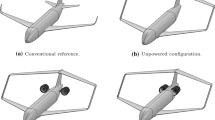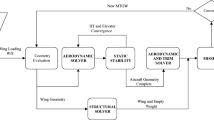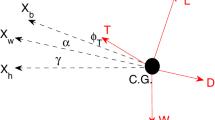Abstract
A hybrid wing body (HWB) concept is being considered by NASA as a potential subsonic transport aircraft that meets aerodynamic, fuel, emission, and noise goals in the time frame beyond 2035. While the concept promises advantages over a conventional wing-and-tube aircraft, it poses unknowns and risks, thus requiring in-depth and broad assessments. Specifically, the configuration entails a tight integration of the airframe and propulsion geometries; the aerodynamic impact has to be carefully evaluated. With the propulsion nacelle installed on the (upper) body, the lift and drag are affected by the mutual interference effects between the airframe and nacelle. The static margin for longitudinal stability is also adversely changed. In the present paper, a design approach is developed in which the integrated geometries of airframe (HWB) and propulsion are accounted for simultaneously in a simple algebraic manner, via parameterization of the planform and airfoils at the design sections of the wing body. This paper presents a design of a 300-passenger aircraft that employs distributed electric fans for the propulsion. The trim condition for stability is achieved through the use of the wing tip twist angle. The geometric shape variables are determined through the adjoint optimization method by minimizing the drag while subjecting them to lift, pitching moment, and geometry constraints. An Euler model-based aerodynamic shape optimization is employed to save the design cost for the evaluation of the static margin and longitudinal stability, while the performance of the optimized configuration is evaluated by the RANS model coupled with a drag decomposition method to assess the true aerodynamic performance. The design results clearly show the influence on the aerodynamic characteristics of the installed nacelle and trimming for stability. A drag minimization with the trim constraint yields a reduction of 10 counts in the drag coefficient from the baseline design N3-X configuration, which is comparable with 2000 lbs more payload on a conventional subsonic civil transport airplane.




















Similar content being viewed by others
Notes
Authors’ note in responding to the appropriateness of the fidelity and feasibility of widely used CFD propulsion models is made as an Appendix to the manuscript, apart from the main focus of the present study in the aerodynamic design of airframe with nacelle rather than BLI propulsion itself. The Appendix details an in-depth discussion regarding authors’ justifications and studies on the consequent design of the embedded propulsion airframe integration configuration. The subjects include propulsion modeling and propulsor design for the tightly coupled airframe and propulsion system.
Abbreviations
- α :
-
Angle of incidence
- ∆:
-
Increment
- η :
-
Nondimensional y-coordinate
- η local :
-
Nondimensional local y-coordinate
- Λ1 :
-
Sweep angle of leading edge of planform
- Λ2 :
-
Sweep angle of outboard wing of planform
- λ1 :
-
Coefficient representing distance between cabin body and root chord of outboard wing
- λ2 :
-
Coefficient representing reach of curved section of leading edge of outboard wing
- λ3 :
-
Coefficient representing reach of curved section of trailing edge of outboard wing
- ψ :
-
Nondimensional CST x-coordinate
- θ wt :
-
Twist angle of outboard wing tip
- ξln ξn,low :
-
Nondimensional trailing edge thickness for lower surface of nth control airfoil on aircraft
- ξun ξn,up :
-
Nondimensional trailing edge thickness for upper surface of nth control airfoil on aircraft
- ζlow :
-
Nondimensional CST z-coordinate for airfoil lower surface
- ζup :
-
Nondimensional CST z-coordinate for airfoil upper surface
- A low :
-
CST optimization variable vector for lower surface of airfoil
- A up :
-
CST optimization variable vector for upper surface of airfoil
- AC:
-
Aerodynamic center
- ADP:
-
Aerodynamic design point
- b ow :
-
Span of outboard wing
- b :
-
Span of wing
- b 2 :
-
Half span of wing
- BFGS:
-
Broyden–Fletcher–Goldfarb–Shanno
- CG:
-
Center of gravity
- C D :
-
Drag coefficient
- C L :
-
Lift coefficient
- C M :
-
Pitching moment coefficient
- C P :
-
Pressure coefficient
- c local :
-
Local chord length
- c r,cb :
-
Root chord of cabin body
- c r,ow :
-
Root chord of outboard wing
- c t,cb :
-
Tip chord of cabin body
- c t,ow :
-
Tip chord of outboard wing
- CFD:
-
Computational fluid dynamics
- CST:
-
Class function/shape function transformation
- DEP:
-
Distributed electric propulsion
- F :
-
Objective function
- \( \overrightarrow {h} \) :
-
Offset vector of control airfoils for aircraft
- H nacelle :
-
Height of nacelle as referenced from surface of aircraft
- l cb :
-
Length of cabin body
- LE:
-
Leading edge
- MAC:
-
Mean aerodynamic chord
- M :
-
Mach number
- N :
-
Bernstein polynomial order for CST airfoil generation of aircraft
- N 1, N 2 :
-
Class function exponent for CST airfoil generation of aircraft
- PAI:
-
Propulsion–airframe integration
- RANS:
-
Reynolds-averaged Navier–Stokes
- SM:
-
Static margin
- TE:
-
Trailing edge
- x LE :
-
Leading edge position vector
- X :
-
Dimensionalized CST x-coordinate
- Y :
-
Dimensionalized CST y-coordinate
- Z cg :
-
Dimensionalized CST z-coordinate of airfoil center of gravity
- Z low :
-
Dimensionalized CST z-coordinate for airfoil lower surface
- Z up :
-
Dimensionalized CST z-coordinate for airfoil upper surface
- V:
-
Volume
- w cb :
-
Width of cabin body
- B:
-
Baseline
- cg:
-
Center of gravity
- T:
-
Target
- wt:
-
Wing tip
- up:
-
Upper
- low:
-
Lower
- D:
-
Drag
- L:
-
Lift
- M:
-
Pitching moment
- P:
-
Pressure
- cb:
-
Cabin body
- ow:
-
Outboard wing
- r:
-
Root
- n :
-
Index 1, 2, 3…
- nacelle:
-
Nacelle
- local:
-
Local
- baseline:
-
Baseline
- shock:
-
Wave drag domain
- viscous:
-
Viscous drag domain
- ind:
-
Induced
References
Liebeck, R.H.: Design of the blended wing body subsonic transport. J. Aircr. 41(1), 10–25 (2004). https://doi.org/10.2514/1.9084
Dowling, A, Greitzer, E.D.: The silent aircraft initiative: overview. 45th AIAA Aerospace Sciences Meeting and Exhibit, AIAA Paper 2007–0452 (2007)
de la Rosa Blanco, E., Hall, C.A., Crichton, D.: Challenges in the silent aircraft engine design. 45th AIAA Aerospace Sciences Meeting and Exhibit, AIAA Paper 2007-454 (2007). https://doi.org/10.2514/6.2007-454
Thomas, R.H., Burley, C.L., Olson, E.D.: Hybrid wing body aircraft system noise assessment with propulsion airframe aeroacoustic experiments. 16th AIAA/CEAS Aeroacoustics Conference, AIAA Paper 2010-3913 (2010). https://doi.org/10.2514/6.2010-3913
Smith Jr., L.H.: Wake ingestion propulsion benefit. J. Propul. Power 9(1), 74–82 (1993). https://doi.org/10.2514/3.11487
Nickol, C.L.: Silent aircraft initiative concept risk assessment. NASA/TM 2008-215112 (2008)
Lyu, Z., Martins, J.R.R.A.: Aerodynamic design optimization studies of a blended-wing-body aircraft. J. Aircr. (2014). https://doi.org/10.2514/1.C032491
Liou, M.-S., Lee, B.J.: Minimizing inlet distortion for hybrid wing body aircraft. J. Turbomach. 134(3), 031020 (2011). https://doi.org/10.1115/1.4003072
Felder, J.L., Kim H.D., Brown, G.V., Chu, J.: An examination of the effect of boundary layer ingestion on turboelectric distributed propulsion systems. 49th AIAA Aerospace Sciences Meeting Including the New Horizons Forum and Aerospace Exposition, AIAA Paper 2011-300 (2011). https://doi.org/10.2514/6.2011-300
Chima, R.V.: Rapid calculations of three-dimensional inlet/fan interaction. NASA Fundamental Aeronautics 2007 Annual Meeting, New Orleans, LA (2007)
Liou, M.-S., Kim, H., Liou, M.-F.: Challenges and progress in aerodynamic design of hybrid wingbody aircraft with embedded engines. NASA/TM 2016-218309 (2016)
Kim, H., Liou, M.-S.: Flow simulation of N3-X hybrid wing-body configuration. 51st AIAA Aerospace Sciences Meeting Including the New Horizons Forum and Aerospace Exposition, Grapevine, TX, AIAA Paper 2013-0221 (2013). https://doi.org/10.2514/6.2013-221
Kim, H., Liou, M.-F., Liou, M.-S.: Mail-slot nacelle shape design for N3-X hybrid wing-body configuration. 51st AIAA/SAE/ASEE Joint Propulsion Conference, AIAA Paper 2015-3805 (2015). https://doi.org/10.2514/6.2015-3805
Kulfan, B.M.: Universal parametric geometry representation method. J. Aircr. 45(1), 142–158 (2008). https://doi.org/10.2514/1.29958
Otani, I., Maughmer, M.D.: The conceptual design of a tailless sailplane having a stabilizing fuselage. Tech. Soar. 31(3), 79–89 (2007)
Etkin, B.: Dynamics of Flight: Stability and Control, 2nd edn. Wiley, New York (1982). ISBN 0-47 1-0341 8-5
Laughlin, T.W., Corman, J.A., Mavris, D.N.: A parametric and physics-based approach to structural weight estimation of the hybrid wing body aircraft. 51st AIAA Aerospace Sciences Meeting including the New Horizons Forum and Aerospace Exposition, AIAA Paper 2013–1082 (2013). https://doi.org/10.2514/6.2013-1082
Kim, H., Harding, D., Gronstal, D.T., Liou, M.-F., Liou, M.-S.: Aerodynamic design of hybrid wingbody with nacelle: N3-X propulsion-airframe configuration. 34th AIAA Applied Aerodynamics Conference, AIAA Paper 2016-3875 (2016). https://doi.org/10.2514/6.2016-3875
Campbell, R.L., Carter, M.B., Pendergraft Jr., O.C., Friedman, D.M., Serrano, L.: Design and testing of a blended wing body with boundary layer ingestion nacelle at high Reynolds numbers (invited). 43rd AIAA Aerospace Sciences Meeting and Exhibit, AIAA Paper 2005–459, 2005. https://doi.org/10.2514/6.2005-459
Clancy, L.J.: Aerodynamics, Ch. 16. Pitman Publishing Limited, London (1975)
Kim, H.-J., Sasaki, D., Obayashi, S., Nakahashi, K.: Aerodynamic optimization of supersonic transport wing using unstructured adjoint method. AIAA J 39(6), 1011–1020 (2001). https://doi.org/10.2514/2.1441
Vanderplaats, G.N.: Multidiscipline Design Optimization, 1st edn. Vanderplaats Research & Development, Novi (2007)
Yamazaki, W., Matsushima, K., Nakahashi, K.: Drag prediction, decomposition and visualization in unstructured mesh CFD solver of TAS-code. Int. J. Numer. Methods Fluids 57, 417–436 (2008). https://doi.org/10.1002/fld.1643
Yamazaki, W., Matsushima, K., Nakahashi, K.: Unstructured mesh drag prediction based on drag decomposition. European Conference on Computational Fluid Dynamics, Delft, The Netherlands (2006)
Reist, T.A., Zingg, D.W.: High-fidelity aerodynamic shape optimization of a lifting-fuselage concept for regional aircraft. J. Aircr. 54(3), 1085–1097 (2017). https://doi.org/10.2514/1.C033798
Kim, H., Liou, M.-F., Liou, M.-S.: CFD study of propulsion-airframe interference on the N3-X hybrid wing-body configuration. ISABE 2015-20228 (2015)
Kim, H., Liou, M.-F.: Flow simulation and drag decomposition study of N3-X hybrid wing-body configuration. Aerosp. Sci. Technol. 85, 24-39 (2019). https://doi.org/10.1016/j.ast.2018.11.047
Van Dam, C.P.: Aircraft Design and the Importance of Drag Prediction, VKI Lecture Series 2003-2: In: CFD-Based Aircraft Drag Prediction and Reduction 2. National Institute of Aerospace, Hampton, VA (2003)
Lee, B.J., Liou, M.-F., Kim, H.: Aerodynamic conceptual design of boundary layer ingestion propulsor systems: hybrid wingbody aircraft with propulsion-airframe-integration. 2018 Applied Aerodynamics Conference, AIAA Paper 2018-3954 (2018). https://doi.org/10.2514/6.2018-3954
Lee, B.J., Liou, M.-F., Celestina, M.: Conceptual design of distributed counter-rotating fan systems for boundary layer ingesting propulsion. ISABE 2019-24285, 22–27 Sept 2019
Biedron, R., Carlson, J., Derlaga, J., Gnoffo, P., Hammond, D., Jones, W., Kleb, B., Lee-Rausch, E., Nielsen, E., Park, M., Rumsey, C., Thomas, J., Wood, W.: FUN3D Manual: 13.3. NASA/TM 2018-219808
Acknowledgements
The authors would like to thank William Haller who is the Technical Lead of the System Analysis & Integration Task and are grateful for the support of the NASA Advanced Air Transport Technology (AATT) Project. The authors would like to thank late Meng-Sing Liou for his unforgotten leadership in our hybrid wing body research. Meng-Sing Liou had been actively involved in this work, even though he was very ill at the time this paper was completed in 2017. His guidance led us to advance this research to complete the design of a distributed and embedded propulsion system of counter-rotating fans for N3-X-DEP300 in 2019.
Author information
Authors and Affiliations
Corresponding author
Additional information
Communicated by C.-H. Chang.
Publisher's Note
Springer Nature remains neutral with regard to jurisdictional claims in published maps and institutional affiliations.
H. Kim is currently affiliated with Department of Mechanical Engineering, Kyung Hee University, Seoul, Republic of Korea.
Appendix
Appendix
Boundary-layer ingesting (BLI) propulsion has long been exploited by propulsion devices for marine craft, and significant improvements have been achieved because the flow physics involves the low Reynolds flow regime. Even though its benefit is not expected to be as great as in marine applications due to the much thinner wake generated on air vehicles, interest in its application has arisen in the aviation community. The BLI effect is still under exploration due to few experiments and studies having been conducted, especially from the perspective of propulsion–airframe integration (PAI). After the present PAI configuration aerodynamic study was completed in 2017, the N3-X-DEP300 development has been focused on the design and optimization of its propulsion system, including the components of inlet/nozzle, i.e., the flow path [29], and sets of counter-rotating fans [30]. The authors not only realized a need to address the reasoning why the Euler model-based optimization was employed in the present paper over the RANS-based one, but also felt the desire to share the knowledge and lessons learned in the BLI propulsion. Meanwhile, the authors would like to keep the original form of the paper as close as possible to what our deceased co-author last saw. In lieu of rewriting the paper, the authors thus leave the following justification and discussion regarding the multidisciplinary subject of PAI as notes in this Appendix.
Choosing the inviscid assumption for the PAI configuration design is for two reasons. Firstly, the optimization results are mainly driven by the reduction in the induced drag. The induced drag of the present hybrid wing body configuration is found to be almost independent of both the wave and viscous drag components as the baseline configuration does not experience significantly strong shock waves or shock-induced separation on the main airframe (see Table 3). Hence, the results from the mid-field drag decomposition method for the original N3-X PAI configuration [27] showed that the lift-to-induced-drag ratio estimated by the Euler analysis agrees well with the RANS model. Secondly, the propulsion modeling that the current study adopted is based on the 1-D model and setting a CFD outlet boundary condition at the inlet face. However, this coupling does not properly work in the RANS model, while it works reasonably in the Euler model for the design mass flow rate condition. In the case of the RANS model, the 1-D back pressure boundary condition in a CFD domain cannot simulate the static pressure profile at the inlet face; thus, the boundary-layer profile could be easily distorted due to numerical issues. Meanwhile, the Euler model can decouple the effect of the static pressure distortion from the shape of the ingested flow stream.
To validate the second argument, the effect of the propulsion models toward the static pressure distortion in the root section (y/b2 = 1.5%) is compared in Fig. 21 for an optimized N3-X-DEP300 PAI configuration. Both RANS and Euler analyses adopt the propulsor design mass flow rate condition, \( \dot{m} \) = 810 kg/s (a cruise flight condition). Note that the propulsion models, also referred to as engine models, applied in this study are the 1-D boundary condition with NPSS data [9], an actuator disk (AD) model [31], and a body force model [13, 30] proposed for a BLI propulsor. The last two are higher-fidelity propulsion models than the 1-D model. Figure 21b, d shows the pressure contours of the AD and body force models, respectively, and indicates two series of shock waves on the nacelle outer mold line (OML). The inviscid calculation seems to capture the same feature as shown in Fig. 21a, while the RANS result with the 1-D model in Fig. 21c fails to predict the first shock wave. Here, it is noted that all the RANS calculations are done on the same level of the mesh refinements with identical surface mesh distribution while the inviscid calculation is directly from a coarser mesh that is used during the Euler model-based optimization.
Figure 22 depicts flow features further close-up near the inlet region of all the cases. A noticeable difference in the exit pressure contour level at the upstream of the inlet is observed between the inviscid (Fig. 22a) and RANS (Fig. 22c) results, both with the 1-D boundary condition, i.e., mass flow outlet boundary condition. Considering the flow blockage due to the low-momentum flow near the airframe wall in the boundary-layer ingestion cases (RANS cases), the boundary condition tends to lower the back pressure to redeem the desired mass flow rate. The lowered constant back pressure, which is lower than those of the high-fidelity engine models in Fig. 22b, d at the shroud region, generates an excessive suction effect; thus, a strong shock accompanied with a significant expansion is observed near the inlet throat region in Fig. 22c. Hence, the incidence angle of the ingested stream tubes near the inlet highlight differs from the cases taking the static pressure distortion at the inlet face into account, as shown in Fig. 22b, d. In the case of the inviscid assumption in Fig. 22a, the trend is opposite. The flow near the airframe wall still keeps momentum; the ingested stream tube near the wall thus diffuses. The effect generates positive incidence toward the inlet highlight. Consequently, the static pressure distribution near the airframe wall in Fig. 22a is observed higher than in other cases, but the pressure distribution and incidence near the shroud and inlet highlight are kept similar to those of the high-fidelity engine models.
Figure 23 displaying the surface pressure distribution along the section at y/b2 = 1.5% near the wing root area shows the difference in a quantitative manner. The different mechanism of the ingested stream tube shaping caused by the 1-D boundary condition affects the upstream potential flow field as shown in Fig. 23. Up to x = 17 m, the pressure distributions show a good agreement, while the cases start showing deviation from each other as the flow stream tube encounters an adverse pressure gradient. Interestingly, the RANS result with the 1-D engine model that has the boundary-layer profile is affected much more than the inviscid result. The fact that the potential flow field on the airframe could be affected by the engine model is indicated by the AD model showing a small shock structure at x = 21 m, while others do not. The inviscid model follows well with the trend of the two high-fidelity models even at the near trailing edge and the nacelle OML regions, while the RANS model with the 1-D boundary condition shows a significant deviation. The only deviation that the inviscid model exhibits could be found at the upper wing surface near the inlet entrance about x = 29–31 m due to the above-explained stream tube shaping at the airframe wall.
The bottom lines derived from the authors’ studies are as follows:
- 1.
The propulsion system affects the fuselage potential flow field. The authors would not name it a “BLI effect,” but “the effect of the embedded propulsion system toward the fuselage aerodynamics.”
- 2.
However, the effect is limited to the location where the adverse pressure gradient starts along the flight direction, i.e., at x = 17 m location in Fig. 23b, in high transonic flight conditions.
- 3.
The effect of the propulsor operation cannot be appropriately incorporated without knowing the propulsor design. For instance, the body force model can only be incorporated after the conceptual propulsor design [30] is completed and the AD model needs at least the flow path geometry inside the nacelle. Hence, from the perspective of PAI, the impact of the employed propulsor model is more significant than the fidelity of the flow analysis methods.
- 4.
The actuator disk or zone models predict much better than the 1-D model does in terms of the modeling of the static pressure distortion at the inlet face of the embedded system. The impact toward the potential flow field over the upstream airframe is more critical than the debate about the Euler and RANS models.
- 5.
With the 1-D boundary condition, the RANS model is not able to predict the impact of the propulsor appropriately for the design mass flow rate condition as presented in Figs. 21, 22, and 23, while the Euler model provides a better interpretation of the airframe performance which is decoupled from it. Thus, the Euler model seems more appropriate in the case that the airframe designer does not know much about the effect of the engine operation.
- 6.
The aft-loaded shock location and shock-induced separation could have misled the Euler model-driven aero-design, but the present study of the N3-X-DEP300 is not the case. Tables 2 and 3 show that the drag caused by the shock loss in the optimized configuration is less than 1% of the total drag for both the Euler and RANS models. In addition, no change in the viscous loss between the two models is indicated in Table 3. Thus, the Euler model-based optimization adopted is appropriate in the present study, but by no means can be generalized for other cases.
Rights and permissions
About this article
Cite this article
Liou, MF., Kim, H., Lee, B. et al. Aerodynamic design of integrated propulsion–airframe configuration of a hybrid wing body aircraft. Shock Waves 29, 1043–1064 (2019). https://doi.org/10.1007/s00193-019-00933-z
Received:
Revised:
Accepted:
Published:
Issue Date:
DOI: https://doi.org/10.1007/s00193-019-00933-z







